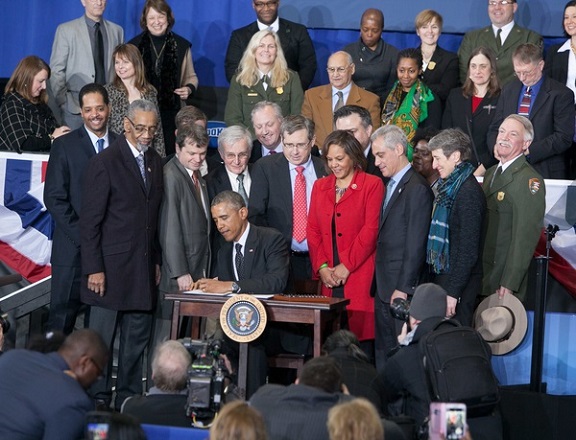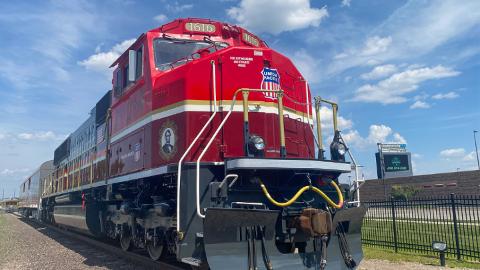A piece of railroad history – the Pullman Historic District located on Chicago's south side – was officially designated a National Monument Feb. 19 by President Barack Obama.
A piece of railroad history – the Pullman Historic District located on Chicago's south side – was officially designated a National Monument Feb. 19 by President Barack Obama.
"What makes Pullman special is the role it plays in our history," President Obama said. "This place has been a milestone in our journey toward a more perfect union."
Built in the 1880s as an industrial town for the Pullman Company, the historic district highlights both the promise of American opportunity and the struggles for civil rights and fair labor standards.
Pullman History
George Pullman, together with Andrew Carnegie, approached Union Pacific Vice President Thomas C. Durant in 1867 with the idea of sleeper cars. Union Pacific responded, taking a controlling interest in the Pacific Pullman Company. Pullman cars of the 1860s and '70s eased travel and offered some luxury, notwithstanding the perils of early train travel. The Pullman Company eventually would add diners, parlor cars, observation cars and other passenger train cars to their line, constantly making improvements in their product.
Their efforts were not lost on the public. The lavish passenger trains of the 1930s touched off an industrial and architectural design movement which expressed itself in streamlined chrome, plastic, synthetic fiber and coordinated color schemes. Pullman passengers and staff alike enjoyed a world of fine wood, excellent upholstery and polished metal. Opulence, food you couldn't find at any restaurant back home and perfect service were the Pullman's stock in trade.
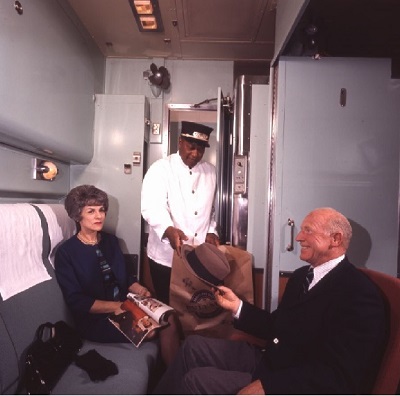
A '50s-era promotional photo of the interior of a Pullman car.
To provide that service, Pullman hired hundreds of maids, porters, cooks and waiters at a time when thousands of recently freed slaves were starting new lives. Beginning in the late 1860s, the Pullman Company offered jobs to African Americans who had very few other opportunities. For nearly 100 years, the Pullman Company hired almost exclusively African Americans, becoming the largest single employer of African Americans in the United States. The Department of Labor’s 1926 report counted more than 20,000 African Americans working as railroad porters, making them the largest category of black labor on U.S. railroads.
Most Pullman employees took great pride in their work and valued the opportunities the jobs provided. In an effort to reduce discrimination and improve working conditions, African American porters formed the Brotherhood of Sleeping Car Porters (BSCP) in 1925. The union’s founder and president, A. Philip Randolph, negotiated for years with the Pullman Company to win recognition of the nation’s first African-American labor union.
Randolph used the BSCP as a platform to fight for black civil rights. With diplomacy and measured arguments, Randolph convinced Presidents Roosevelt and Truman to pass important anti-discrimination laws, earning a post as the first black vice president of the AFL-CIO, America’s largest federation of unions.
The Monument
"The Pullman National Monument is a fitting tribute to George Pullman and his dream of providing a quality passenger rail car, the nation's first planned community, the nation's first African-American union and so much more,” said Bob Turner, Union Pacific senior vice president of Corporate Relations and Union Pacific Foundation president.
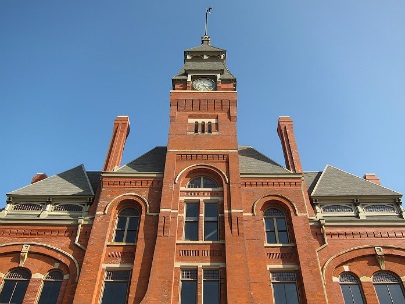
The Pullman Clock Tower and Administration Building in Chicago. Photo: National Park Service
"Mr. Pullman's accomplishment touched the lives of many employees at Union Pacific and across the rail industry," Turner added. "We are honored to partner with the City of Chicago and other community stakeholders to be a part of this historic endeavor in creating the Pullman National Monument."
Donations, including $1 million provided by the Union Pacific Foundation, will help jumpstart critical projects at the new park, including the establishment of a visitor center, educational and experiential exhibits, and programming in the Administrative Clock Tower Building designed to engage schoolchildren, the community, and visitors about the importance of Pullman to America's collective history.
"This new national monument is another step forward in Pullman's comeback story," said Chicago Mayor Rahm Emanuel, who introduced the president at the event. "From now on, Pullman belongs not just to Chicago but to all of America and I am proud of everyone who made this day possible."
"What makes Pullman special is the role it plays in our history. This place has been a milestone in our journey toward a more perfect union."
President Barack Obama
"This new national monument is another step forward in Pullman's comeback story," said Chicago Mayor Rahm Emanuel, who introduced the president at the event. "From now on, Pullman belongs not just to Chicago but to all of America and I am proud of everyone who made this day possible."
Other officials on hand for the ceremony included U.S. Secretary of the Interior Sally Jewell, Illinois Gov. Bruce Rauner, U.S. Sen. Mark Kirk, Congresswoman Robin Kelly, Congressman Mike Quigley, Congessman Bobby Rush and Congressman Bob Dold.
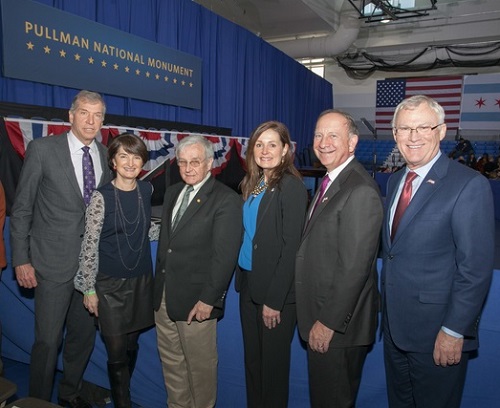
At the signing ceremony, from left, are Dr. Bryan Traubert, President of the Chicago Park District Board of Commissioners; Ellen Alberding, President of The Joyce Foundation; Michael Shymanski, President of the Historic Pullman Foundation; and Union Pacific's Donna Kush, Vice President-Public Affairs; Jack Koraleski, Executive Chairman; and Bob Turner, Senior Vice President-Corporate Relations.

